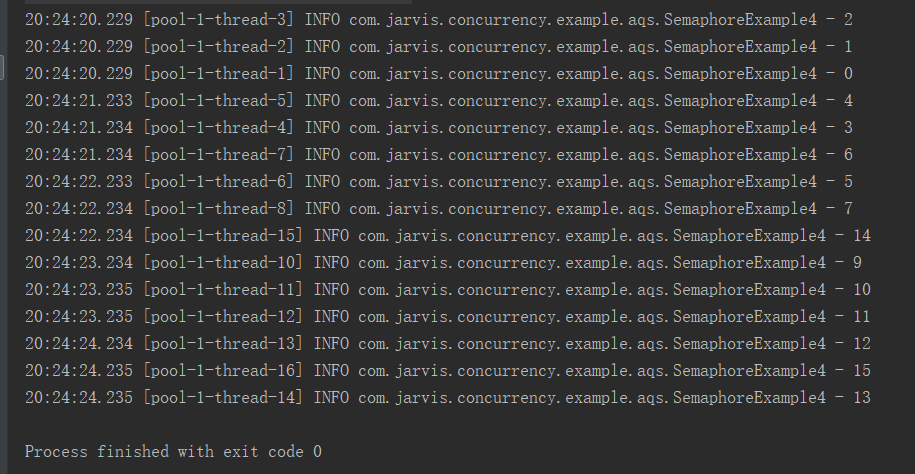并发编程(三):并发模拟
我们要如何模拟一个高并发的环境来检查我们的代码呢?一般常用的方式有三种:利用测试工具ab,利用jmeter,代码模拟。本篇博客着重要说的是代码模拟的实现方式。
在开始写代码之前我们首先了解一下J.U.C中特别重要的两个工具类:CountDownLatch、Semaphore
CountDownLatch(闭锁)
CountDownLatch是一个同步工具类,它允许一个或多个线程一直等待,直到其他线程的操作执行完后再执行。CountDownLatch是通过一个计数器来实现的,当计数器的值为0时,在闭锁上等待的线程就可以恢复执行任务
public CountDownLatch(int count) { if (count < 0) throw new IllegalArgumentException("count < 0"); this.sync = new Sync(count); }
从此类的构造方法可以看出,构造此类需要传入count,这个值只能被设置一次,而且这个计数值不能被重置

countDown()方法:每调用一次这个方法,构造函数中的count值减1
await()方法:调用此方法的线程会在这个方法上阻塞,直到count值为0才继续执行自己的任务
CountDownLatch-demo1
@Slf4j public class CountDownLatchExample1 { private final static int threadCount = 200; public static void main(String[] args) throws Exception{ ExecutorService exec = Executors.newCachedThreadPool(); final CountDownLatch countDownLatch = new CountDownLatch(threadCount); for (int i = 0; i < threadCount; i++) { final int threadNum = i; exec.execute(()->{ try { test(threadNum); } catch (Exception e) { log.error("exception",e); }finally { countDownLatch.countDown(); } }); } countDownLatch.await(); log.info("finish"); //线程池不再使用后关闭 exec.shutdown(); } private static void test(int threadNum)throws Exception { Thread.sleep(100); log.info("{}", threadNum); Thread.sleep(100); } }
输出如下:

此demo1证明了count为0后发生阻塞的线程(调用await()处)才会继续执行
CountDownLatch-demo2
@Slf4j public class CountDownLatchExample2 { private final static int threadCount = 200; public static void main(String[] args) throws Exception{ ExecutorService exec = Executors.newCachedThreadPool(); final CountDownLatch countDownLatch = new CountDownLatch(threadCount); for (int i = 0; i < threadCount; i++) { final int threadNum = i; exec.execute(()->{ try { test(threadNum); } catch (Exception e) { log.error("exception",e); }finally { countDownLatch.countDown(); } }); } //统计的时间为test方法执行的时间 ,如下所示为只等待10毫秒就继续执行 countDownLatch.await(10, TimeUnit.MILLISECONDS); log.info("finish"); //线程池不再使用后关闭,不是直接销毁,会让当前已有的线程执行完然后销毁 exec.shutdown(); } private static void test(int threadNum)throws Exception { Thread.sleep(100); log.info("{}", threadNum); // Thread.sleep(100); } }
输出如下:

demo2表明await()方法支持设置阻塞时间,如果等待时间查过设置的阻塞时间,则发生阻塞的线程继续向下执行(可参考await()的重载)
Semaphore(信号量)
Semaphore管理一系列许可证,Semaphore的acquire请求许可证,获得许可证可继续执行,否则发生阻塞,Semaphore的release方法释放许可证。下面我们来看一下Semaphore的构造方法
public Semaphore(int permits) { sync = new NonfairSync(permits); } public Semaphore(int permits, boolean fair) { sync = fair ? new FairSync(permits) : new NonfairSync(permits); }
从构造方法可以看出,两个构造方法都必须提供许可证的数量(可理解为同时并发执行的线程数),不同的是第二个构造方法还需要指定是公平模式还是非公平模式,默认为非公平模式。公平模式是指调用acquire的顺序就是获取许可证的顺序,遵循FIFO;非公平模式是抢占式的,可能一个新的获取线程恰好在许可证释放的时候得到了许可证,而它前面还有在等待许可证的线程
Semaphore-demo1
@Slf4j public class SemaphoreExample1 { private final static int threadCount = 20; public static void main(String[] args) throws Exception{ ExecutorService exec = Executors.newCachedThreadPool(); final Semaphore semaphore = new Semaphore(3); for (int i = 0; i < threadCount; i++) { final int threadNum = i; exec.execute(()->{ try { semaphore.acquire(); //获取一个许可 test(threadNum); semaphore.release(); //释放一个许可 } catch (Exception e) { log.error("exception",e); } }); } //线程池不再使用后关闭 exec.shutdown(); } private static void test(int threadNum)throws Exception { log.info("{}", threadNum); Thread.sleep(1000); } }
输出如下:

参考demo1的输出可发现同一秒内,只有三个线程在并发执行(信号量为3每次只获取一个许可)
Semaphore-demo2
@Slf4j public class SemaphoreExample2 { private final static int threadCount = 20; public static void main(String[] args) throws Exception{ ExecutorService exec = Executors.newCachedThreadPool(); final Semaphore semaphore = new Semaphore(3); for (int i = 0; i < threadCount; i++) { final int threadNum = i; exec.execute(()->{ try { //并发数为3,并且一下拿走三个许可,已经没有别的许可可以放出来了,所以一个个执行 semaphore.acquire(3); //获取多个许可 test(threadNum); semaphore.release(3); //释放多个许可 } catch (Exception e) { log.error("exception",e); } }); } //线程池不再使用后关闭 exec.shutdown(); } private static void test(int threadNum)throws Exception { log.info("{}", threadNum); Thread.sleep(1000); } }
输出如下:

参考demo2输出可发现,同一秒内只有一个线程在执行(信号量为3,每次获取三个许可),可参考acquire()方法的重载
Semaphore-demo3
@Slf4j public class SemaphoreExample3 { private final static int threadCount = 20; public static void main(String[] args) throws Exception{ ExecutorService exec = Executors.newCachedThreadPool(); final Semaphore semaphore = new Semaphore(3); for (int i = 0; i < threadCount; i++) { final int threadNum = i; exec.execute(()->{ try { //20个请求在同一时间内都会去尝试获取许可,只有三个线程获得了许可 if (semaphore.tryAcquire()) { test(threadNum); semaphore.release(); //释放一个许可 } } catch (Exception e) { log.error("exception",e); } }); } //线程池不再使用后关闭 exec.shutdown(); } private static void test(int threadNum)throws Exception { log.info("{}", threadNum); Thread.sleep(1000); } }
输出如下:

注意上图为demo3完整输出,本次代码中使用的是tryAcquire()而不是acquire()方法,tryAcquire()表示线程会尝试获取许可,如果无法获取许可则此请求被丢弃,信号量为3,每次获取一个许可,所以只有三个线程被执行。
Semaphore-demo4
@Slf4j public class SemaphoreExample4 { private final static int threadCount = 20; public static void main(String[] args) throws Exception{ ExecutorService exec = Executors.newCachedThreadPool(); final Semaphore semaphore = new Semaphore(3); for (int i = 0; i < threadCount; i++) { final int threadNum = i; exec.execute(()->{ try { //只等待5s,没有执行完的线程则丢弃 if (semaphore.tryAcquire(5000,TimeUnit.MILLISECONDS)) { test(threadNum); semaphore.release(); //释放一个许可 } } catch (Exception e) { log.error("exception",e); } }); } //线程池不再使用后关闭 exec.shutdown(); } private static void test(int threadNum)throws Exception { log.info("{}", threadNum); Thread.sleep(1000); } }
输出如下:

参考demo4输出可发现,20个线程只执行了13个,由代码可看出,在5秒内得到许可的线程得到执行(信号量为3,每次获取一个许可),没有得到许可的线程被丢弃(可参考tryAcquire的重载)
高并发-demo
@Slf4j public class CountExample1 { //请求总数 public static int clientTotal = 5000; //同时并发执行的线程数 public static int threadTotal = 200; public static int count = 0; private static void add() { count++; } public static void main(String[] args)throws Exception { //定义线程池 ExecutorService executorService = Executors.newCachedThreadPool(); //定义信号量 final Semaphore semaphore = new Semaphore(threadTotal); //定义计数器闭锁 final CountDownLatch countDownLatch = new CountDownLatch(clientTotal); for (int i = 0; i < clientTotal; i++) { executorService.execute(()->{ try { semaphore.acquire(); add(); semaphore.release(); } catch (Exception e) { log.error("exception",e); } countDownLatch.countDown(); }); } countDownLatch.await(); executorService.shutdown(); log.info("count:{}",count); } }
输出如下:

有个以上基础,我们可知此demo模拟了5000个请求,并发数为200的情况,根据输出结果可知发生了线程安全问题。



